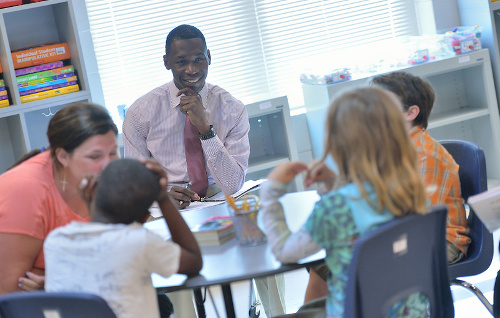
Research shows principals play an essential role in P-3 schools success.
Research suggests elementary school principals are very influential in the success of early childhood classes in schools. According to a report by the Education Commission on the States, the number of pre-kindergarten classes in public schools across the nation are increasing. With increased numbers of classes comes growing student outcome expectations, and more questions related to teacher accountability. Trouble may be on the horizon if the elementary school principal is responsible for observing P-3 classrooms and evaluating teacher performance in addition to monitoring student scores on statewide or local assessments to determine effectiveness.
A report, published in 2014 by the National Association of Elementary School Principals (NAESP), suggests that many new principals lack knowledge on the appropriate instructional methods for teaching young children. According to EdCentral, only four states require elementary principals to have preparation in early language and literacy development prior to leading a school: Minnesota, Illinois, Tennessee and Idaho. Without adequate preparation as school administrators, principals are going to be less than proficient when making decisions and guiding teachers about how appropriate instructional strategies are implemented and practiced in the early grades.
A new look is in order for administrator preparation across the country. The day of workbooks, rote drills and large group instruction as the primary mode of instruction with children seated in desks or tables for most of the day is not going to deliver the student outcomes states identify with success today. Yet, if principals continue to expect classrooms to sound and look like a 1950’s Norman Rockwell painting they will get 1950’s results in a 2016 world.
A NAESP report identifies competencies for school principals to strive to meet if they wish to promote a successful P-3 school. The undertaking is not for the faint of heart and will require additional professional development and preparation in graduate courses and overall leadership development. As states move forward in passing third grade laws pertaining to third grade reading proficiency, more emphasis will be placed on instruction and student outcomes in the grades leading up to third.
School principals who choose to meet NAESP competencies must realize in most instances it will take time to establish a new school climate. When guiding teachers and communicating best practices to stakeholders, many principals will have to literally start by rebuilding the physical arrangement of the learning environment and retraining teachers and adjusting the daily schedule. Retooled classrooms will consists of a literacy rich environment with learning centers. Art and opportunities for dramatic representations of concepts taught through unit themes and student exploration with blocks and other manipulatives are more prevalent than teacher-directed instruction. Instruction will take more of a “hands-on” student and teacher collaboration where intentional teaching takes place to help students meet state standards in all subject areas.
Putting research findings into practice is never easy for many reasons: budgetary constraints, teachers’ reluctance to change, parent misunderstandings about change and overall fatigue as a result of trying to move down the road of positive changes while having to push and pull others down the same road. Seeking out peers, such as those highlighted in the NAESP report, who have successfully achieved a research-based P-3 school with results to prove it, can make the journey less stressful and more productive.


